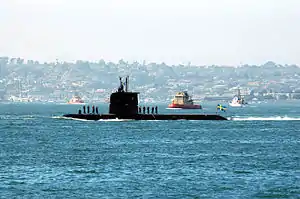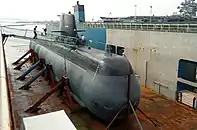Gotland-class submarine
The Gotland-class submarines of the Swedish Navy are modern diesel-electric submarines, which were designed and built by the Kockums shipyard in Sweden. They are the first submarines in the world to feature a Stirling engine air-independent propulsion (AIP) system, which extends their underwater endurance from a few days to weeks.[2] This capability had previously only been available with nuclear-powered submarines.
 HSwMS Gotland | |
| Class overview | |
|---|---|
| Builders: | Kockums |
| Operators: |
|
| Preceded by: | Västergötland class |
| Succeeded by: | Blekinge class |
| Built: | 1992-1996 |
| In commission: | 1996-Present |
| Planned: | 3 |
| Completed: | 3 |
| Active: |
|
| General characteristics | |
| Type: | Submarine |
| Displacement: |
|
| Length: | 60.4 m (198 ft 2 in) |
| Beam: | 6.2 m (20 ft 4 in) |
| Draft: | 5.6 m (18 ft 4 in) |
| Propulsion: |
|
| Speed: |
|
| Complement: |
|
| Sensors and processing systems: | CSU 90-2 Integrated sonar sensor suite |
| Armament: |
|
Features
As of 2008, the Gotland-class attack submarine is one of the most modern submarines of the Swedish Navy in service, mainly designed for submarine missions such as antiship/antisubmarine warfare, collecting of intelligence (communications intelligence (COMINT), electronic signals intelligence (ELINT)), forward surveillance, special operations, and mine-laying tasks.[2]
On the water surface, the submarine is powered by two sets of MTU engines. While submerged, the Kockums-built Stirling engine AIP system is used to drive a 75-kilowatt (101 shp) generator for either propulsion or charging the batteries. A Stirling engine is particularly well suited for a submarine because the engine is near silent and can use the surrounding sea water as a heat sink to increase efficiency. Submerged endurance is dependent on the amount of liquid oxygen stored on-board and is described as "weeks". The class is characterized by its low acoustic signatures, extreme shock resistance, and a competent combat system.[2]
Kockums touts extreme maneuverability for this class due to the hull design and a well-placed X rudder. The X rudder provides four control surfaces, along with two mounted on the sail, which enables sharp turns and the ability to operate very close to the seabed. Ship automation and computerized steering allow a single operator to steer the submarine in depth and course, which also results in a smaller crew complement, leading to good accommodation standards and low operating costs.[3]
The class has many features that enhance stealth, helping it to remain undetected. All shipboard machinery is isolated and mounted on rubber dampeners to reduce vibrations and noises; a hydrodynamic hull design reduces noise, infrared signature, and active sonar response. Its magnetic signature is counteracted by 27 independent electromagnets, short circuiting extremely low frequency (ELF) electrical fields. Various hull coatings reduce active sonar response, and the mast is coated with radar-absorbent material. Combined with the near-silent operation of the Stirling generator and slow-turning propeller to prevent cavitation, the boats are very difficult to detect under water, especially in their normal area of operations, the Baltic Sea.[3]

Units
| Ship name | Laid down | Launched | Commissioned | Service | Status | Coat of arms |
|---|---|---|---|---|---|---|
| HSwMS Gotland (Gtd) | 10 October 1992 | 2 February 1995 | 1996 | 1st Submarine Flotilla | Active | |
| HSwMS Uppland (Upd) | 14 January 1994 | 8 February 1995 | 1996 | 1st Submarine Flotilla | Active | |
| HSwMS Halland (Hnd) | 21 October 1994 | 27 September 1996 | 1996 | 1st Submarine Flotilla | Active | |
Deployments
After being refitted and upgraded to sustain the higher temperatures of tropical water,[4] HSwMS Halland took part in a multi-national exercise in the Mediterranean from September 16, 2000. Allegedly, there she remained undetected while still recording many of her friendly adversaries, attracting interest from the participating countries. In early November the same year, she participated in a NATO "blue-water" exercise in the Atlantic. There, she reportedly won a victory in a mock "duel" with Spanish naval units, and then the same in similar duel against a French SSN, a nuclear-powered attack submarine. She also "defeated" an American SSN, the USS Houston.[4]
Secondment to United States Navy


In 2004, the Swedish government received a request from the United States to lease HSwMS Gotland – Swedish-flagged, commanded and manned, for a duration of one year for use in antisubmarine warfare exercises. The Swedish government granted this request in October 2004, with both navies signing a memorandum of understanding on 21 March 2005.[5][6] The lease was extended for another 12 months in 2006.[7][8][9] In July 2007, HSwMS Gotland departed San Diego for Sweden.[10]
HSwMS Gotland managed to snap several pictures of USS Ronald Reagan during a wargaming exercise in the Pacific Ocean, effectively "sinking" the aircraft carrier.[11] The exercise was conducted to evaluate the effectiveness of the US fleet against diesel-electric submarines, which some have noted as severely lacking.[12][13] In 2001, during the exercise JTFEX 01-2 in the Caribbean Sea, the German U24 of the conventional 206 diesel-electric class "sank" the carrier Enterprise by firing flares and taking a photograph through its periscope.[14]
Overhaul
Initial discussions
In March 2013, Kockums received an initial order for an overhaul for two of the Gotland-class submarines. The overhaul was expected to be completed by 2017. With these upgrades, the submarines would be able to remain in active duty until after 2025.[15] On 2 April 2014, the Swedish defence minister, insisting on the importance of submarines to the security of Sweden, announced the Government's intent to upgrade two of the Gotland-class vessels, as well as purchase two new "stealth" submarines of another type.[16]
Mid-life upgrade contract
Negotiations concluded on 30 June 2015 with the signature of a contract between Sweden's Defense Material Administration (FMV) and Saab Kockums. In addition to the construction of two new Type 26 A SSKs, the contract provides for a mid-life upgrade of HSwMS Gotland and her sister ship HSwMS Uppland, for SEK 2.1 billion. Gotland is expected to return to the FMV in late 2018 and Uppland in late 2019, following a series of platform and combat systems upgrades. Gotland returned to active duty in June 2018 after receiving modification for over 20 systems. Same systems will also be included on the new A26 submarines.[17] HSwMS Uppland relaunched in June 2019[18] and was delivered to the Navy in December 2020.[19]
References
- "SSK Gotland Class (Type A19), Sweden". naval-technology.com. Retrieved 2017-09-20.
- "The Gotland class submarine - submerged several weeks". Kockums. Retrieved 2008-04-06.
- "Kockums Promotional" (PDF). Naval Technology. Retrieved 2011-11-21.
- Kockums.se: News 2000
- "US Navy Leasing Swedish Gotland-Class Submarine". Deagel. Retrieved 2004-11-05.
- "U.S., Swedish Navies Sign Agreement to Bilaterally Train on State-of-the-Art Sub" (Press release). United States Navy. 2005-03-23. Archived from the original on 2007-08-19.
- "US Navy to continue hunt for Swedish sub". The Local. 2006-04-18. Archived from the original on 2009-03-29. Retrieved 2006-07-21.
- "Gotland extends US stay for another year" (Press release). Kockums AB. 2006-06-13. Archived from the original on 2006-10-01. Retrieved 2006-07-21.
- "HMS Gotland's Stirling propulsion system basis of success in the USA" (Press release). Kockums AB. 2007-05-09.
- "SSK Gotland Class (Type A19) Attack Submarine, Sweden". Naval Technology. Retrieved 2008-04-06.
- "Pentagon: New Class Of Silent Submarines Poses Threat". KNBC. 2006-10-19. Archived from the original on 2007-11-16. Retrieved 2006-07-21.
- Polmar, Norman (March 2006). "Back to the Future". U.S. Naval Institute Proceedings. 132 (3): 22–23. 0041-798X.
- "US Navy Struggles to Recapture, Keep ASW Proficiency". The Nav Log. Archived from the original on 2009-02-02. Retrieved 2008-04-06.
- "Deutsches U-Boot fordert US-Marine heraus" (in German). t-online. 2013-01-06. Retrieved 2020-12-18.
- Kleja, Monica (2012-10-05). "Kockums får stor ubåtsorder" [Kockums gets big submarine orders]. Ny Teknik (in Swedish). Retrieved 2017-09-20.
- Knutson, Mats; Benigh, Love (2014-04-02). "Regeringen stoppar planerad ubåtsaffär" [The government stops the planned submarine business]. svt (in Swedish). Retrieved 2017-09-20.
- Ivansson, Hans. "Sjösättning av modifierad ubåt". www.fmv.se.
- "Second Gotland-class Submarine HMS Uppland Relaunched following MLU by Saab". www.navalnews.com.
- https://seawaves.com/?p=7860